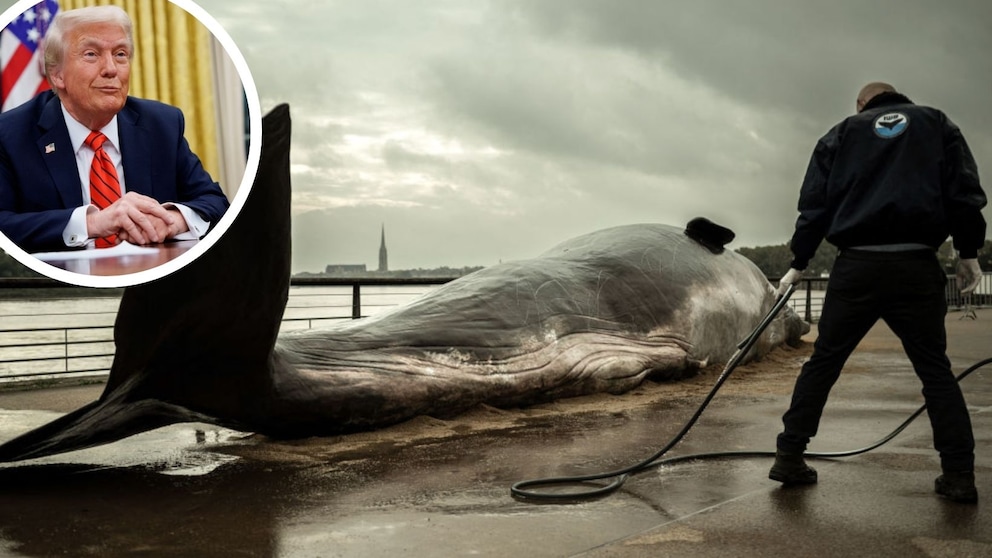February 13, 2025, 4:08 pm | Read time: 5 minutes
Donald Trump has been in office for less than a month, but he is already causing a lot of chaos with his demands and draft legislation. Just a few hours after being sworn in, for example, he issued a ban on new wind turbines. One of the reasons was that wind power was “driving the whales mad.”
Immediately after his inauguration, the new US President, Donald Trump, issued a decree stopping the tendering and construction of new wind turbines supposedly to prevent whale beaching. Wind energy accounts for around ten percent of the electricity supply in the USA. According to the AP news agency, 73 gigawatts of offshore wind turbines are currently under construction. This is enough to supply 30 million households.1 These projects are now to be put on hold, especially those for which permits are still outstanding.2
“Wind turbines are driving the whales mad”
One of the reasons he gave for the halt was that “wind power is driving the whales mad,” and he blames offshore projects for the frequent strandings of large whales on the north coast of the USA.3
However, Donald Trump has not just been waging a literal battle against wind turbines since Monday, February 10. In 2023, during an appearance at a boat manufacturer, he declared that the then US President Biden wanted to introduce a speed limit for motorboats.
According to this, a speed limit of 10 knots was to benefit the protection of whales, among other things. This plan actually existed but was blocked by the Republican Party. However, Trump then claimed to know the real reason for the numerous whale strandings. “On the other hand, their wind turbines are causing whales to die in unprecedented numbers – nobody is doing anything about it,” said Trump.4
Marine Biologists Refute Donald Trump’s Claims
However, several animal welfare organizations have now declared that this is just baseless misinformation that distracts from the real problems. “An unusually high mortality rate of large whales along the US East Coast has been documented by the responsible US authority since 2016. And this was long before offshore wind power projects began on a large scale,” says Whale and Dolphin Conservation spokeswoman Bianca König in response to a PETBOOK inquiry.
According to animal rights activists, the increase in strandings over the last three years has heightened concern for the whales. “In December 2022, around two dozen dead whales (including humpback whales and sperm whales) were washed up on the coasts of New Jersey and New York or discovered in the open sea. Last year alone, six dead whales washed ashore between June and December – most recently, a young humpback whale on the south coast of Massachusetts in December 2024.”
These Are the Real Reasons for Whale Beaching
The organization’s own stranding team conducts detailed investigations on-site to find out more about the cause of death. “There is no construction or preparation work for wind farms in the area off the coast of Massachusetts. The investigations revealed that collisions with ships, entanglement in fishing gear, and the effects of climate change were the main causes of death for the stranded large whales,” says König.
According to WDC’s observations, humpback, minke, and the endangered North Atlantic right whales are stranded particularly frequently. “Further studies suggest that increased fish populations are bringing whales closer to the coast, where the risk of ship collisions and entanglement in fishing gear is increasing.”
What is problematic, however, is that whales are increasingly being used as an argument against offshore wind energy. This does not adequately address the actual risks.
Fatally Injured Mothers Usually Result in Death for Newborns
For years, people have been calling for speed limits for shipping traffic along the Atlantic coast. The aim is to protect, in particular, the endangered Atlantic right whales, of which there are only around 400 individuals left today.
“The existing regulation applies to vessels 19.8 meters or longer and sets seasonal speed limits off Massachusetts, the mid-Atlantic, and the whale calving grounds in Georgia and Florida.”
WDC and other animal welfare organizations are therefore calling on the US authorities to extend the existing speed limits to the open sea. In addition, speed limits should be introduced in the vicinity of New York, New Jersey, Rhode Island, and Virginia.
“This is the only way to prevent ship collisions,” explains Bianca König. “Whale mothers and their young are particularly affected by collisions, as they usually swim more slowly. They can’t get out of the way as quickly and spend a lot of time at the surface.”

Phenomenon Explained Why Dolphins Love Surfing on Waves and Next to Boats

Up to 700 kg Six facts worth knowing about the world’s largest turtle

After the attack Expert: ‘Orcas purposely sink sailing yacht!’
“The oceans are severely threatened by overfishing”
If the mothers are fatally injured, this often also means death for the newborn, explains the whale expert. In principle, the protection of whales and dolphins begins on our own doorstep, says König. This is because 80 percent of the waste in the sea comes from land. This is because it mainly enters the oceans via rivers and beaches.
Clean-up campaigns on riverbanks and beaches could, therefore, save the lives of sea creatures. This is because many whales mistake plastic bags and other waste for food and suffocate or starve to death. “Cuts from sharp-edged waste or strangulation/entanglement in waste can also be fatal.”
Last but not least, Bianca König warns that we should also reconsider our own fish consumption. “The oceans are severely threatened by overfishing. Commercial fishing robs marine mammals of their food source. It also poses a threat to whales and dolphins, which can become entangled or injured as bycatch in fishing gear.” The consumption of fish keeps the demand for fish products high.

